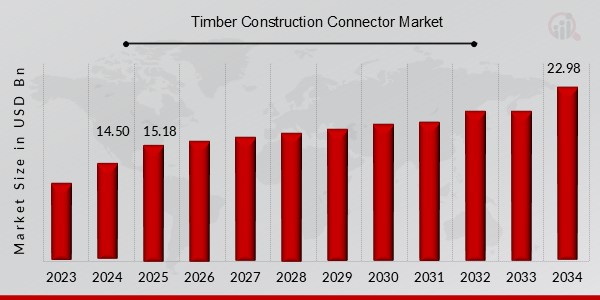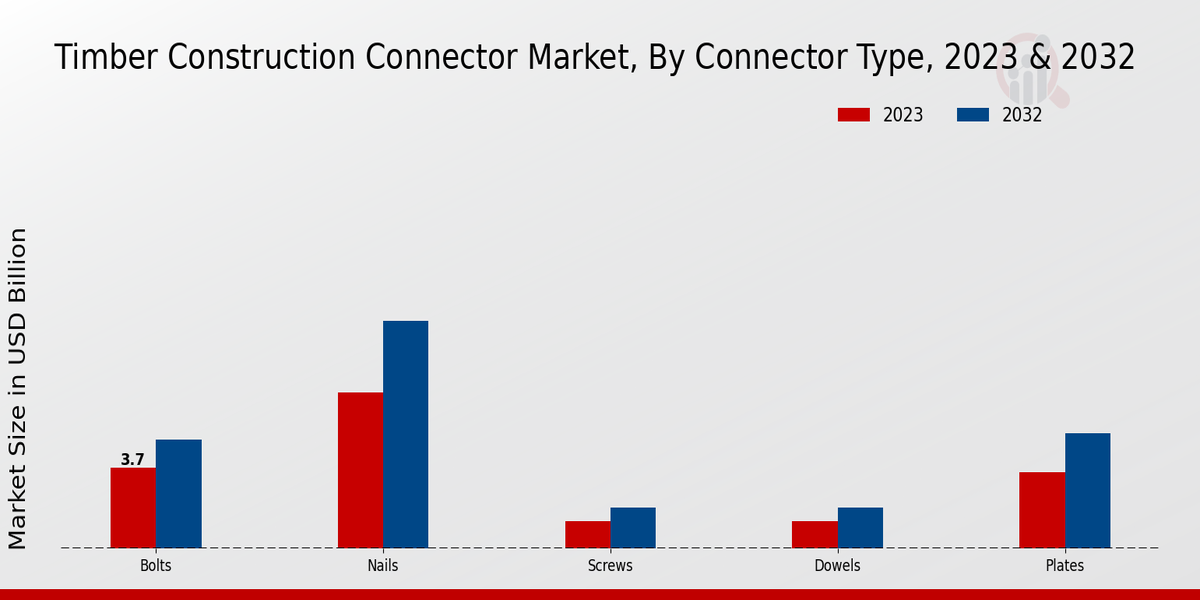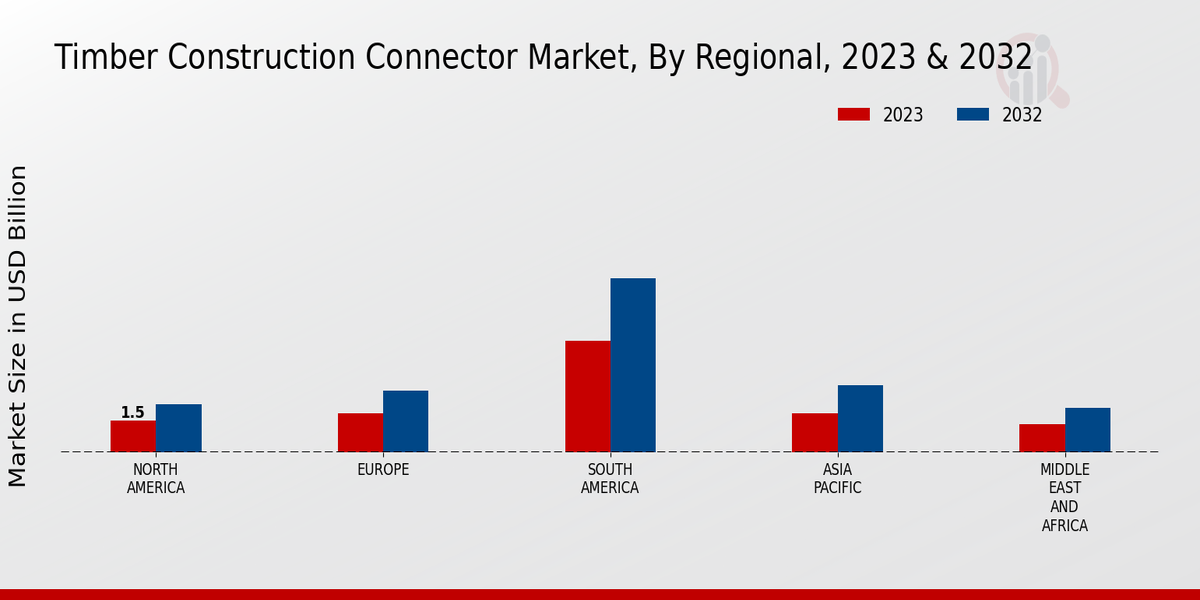Global Timber Construction Connector Market Overview
The Timber Construction Connector Market Size was estimated at 14.50 (USD Billion) in 2024. Timber Construction Connector Industry is expected to grow from 15.18 (USD Billion) in 2025 to 22.98 (USD Billion) by 2034, at a CAGR (growth rate) is expected to be around 4.71% during the forecast period (2025 - 2034)
Key Timber Construction Connector Market Trends Highlighted
Key market drivers for timber construction connectors include rising urbanization, increasing awareness of sustainability, and growing adoption of advanced building techniques. The increasing demand for sustainable and energy-efficient construction methods is driving the adoption of timber construction, and this in turn is driving the demand for specialized connectors that can provide strong and durable connections in timber structures.Opportunities to be explored or captured in the timber construction connector market include the development of new and innovative connector designs, the expansion into new geographical markets, and the integration of advanced technologies and materials. As the construction industry continues to evolve, new opportunities will emerge for connectors that can meet the demands of increasingly complex and innovative buildings.Recent trends in the timber construction connector market include the development of new connector designs that offer increased strength and durability, the adoption of advanced manufacturing techniques, and the growing use of sustainable materials. The increasing use of connectors made from recycled or sustainable materials is also a significant trend, as the construction industry strives to reduce its environmental impact.

Source: Primary Research, Secondary Research, MRFR Database and Analyst Review
Timber Construction Connector Market Drivers
Increasing Demand for Sustainable Building Materials
The growing awareness of environmental issues and the need for sustainable construction practices is driving the demand for timber construction connectors. Timber is a renewable and environmentally friendly material that can help reduce the carbon footprint of buildings. Timber construction connectors allow for the efficient and safe construction of timber structures, making them an attractive option for architects and builders who are looking for sustainable building solutions.The Timber Construction Connector Market Industry is expected to witness significant growth in the coming years, as more and more countries adopt green building codes and regulations.
Rising Popularity of Modular Construction
The increasing popularity of modular construction is also contributing to the growth of the Timber Construction Connector Market Industry. Modular construction involves the prefabrication of building components in a factory setting, which are then assembled on site. Timber construction connectors are ideal for modular construction, as they allow for the quick and easy assembly of timber structures. This efficiency and cost-effectiveness are driving the adoption of modular construction, which in turn is increasing the demand for timber construction connectors.
Growing Demand for Affordable Housing
The growing demand for affordable housing is another factor driving the growth of the Timber Construction Connector Market Industry. Timber is a relatively affordable building material, and timber construction connectors can help to further reduce construction costs. This makes timber construction an attractive option for developers who are looking to build affordable housing units. The increasing demand for affordable housing is expected to continue in the coming years, as more and more people are priced out of the traditional housing market.
Timber Construction Connector Market Segment Insights:
Timber Construction Connector Market Connector Type Insights
Connector Type Segment Overview and Insights The Timber Construction Connector Market is segmented by connector type into bolts, nails, screws, dowels, and plates. Among these, bolts held the largest market share in 2023, accounting for approximately 35% of the global revenue. This dominance is attributed to their high strength and load-bearing capacity, making them ideal for heavy-duty timber construction applications. Nails, the second-largest segment, are expected to witness steady growth during the forecast period 2023-2032. Their low cost and ease of installation make them popular for residential and light commercial timber construction projects.Screws, on the other hand, are gaining traction due to their superior holding power and resistance to withdrawal, particularly in engineered timber structures. Dowels and plates represent niche segments within the timber construction connector market. Dowels are primarily used in traditional timber framing methods and are gradually being replaced by more advanced connectors. Plates, which offer high strength and rigidity, are typically employed in large-scale timber structures such as bridges and industrial buildings. The growth of the timber construction connector market is closely tied to the rising demand for sustainable and eco-friendly building materials.Timber construction offers numerous environmental benefits, such as reduced carbon footprint, energy efficiency, and improved indoor air quality. As a result, governments worldwide are promoting the use of timber in construction projects, driving demand for specialized connectors. Technological advancements are also shaping the timber construction connector market. The development of innovative connectors with improved strength, durability, and ease of installation is expected to further fuel market growth. Additionally, the adoption of digital tools and Building Information Modeling (BIM) is streamlining the design and construction processes, creating new opportunities for connector manufacturers.

Source: Primary Research, Secondary Research, MRFR Database and Analyst Review
Timber Construction Connector Market Material Insights
The Timber Construction Connector Market is segmented by Material into Steel, Stainless Steel, Aluminum, Timber, and Composite Materials. Among these segments, Steel held the largest market share in 2023, accounting for around 45.0% of the global revenue. Steel connectors are widely used in timber construction due to their high strength, durability, and cost-effectiveness. The growing demand for steel connectors is primarily driven by the increasing construction activities in residential and commercial sectors. Stainless Steel is another important material used in timber construction connectors, and it is expected to witness a significant growth rate during the forecast period.Stainless steel connectors are resistant to corrosion and rust, making them suitable for use in harsh environments. The increasing adoption of stainless steel connectors in marine and coastal construction is expected to drive the growth of this segment. Aluminum connectors are gaining popularity in timber construction due to their lightweight and high strength-to-weight ratio. Aluminum connectors are also corrosion-resistant and recyclable, making them an environmentally friendly option. The growing demand for aluminum connectors in the construction of bridges, stadiums, and other large-scale structures is expected to contribute to the growth of this segment.Timber connectors are used to join timber members together, and they are typically made of wood or wood-based materials. Timber connectors are cost-effective and easy to install, making them a popular choice for residential and commercial construction. The growing demand for timber connectors is expected to drive the growth of this segment. Composite Materials are also used in the production of timber construction connectors. Composite materials offer a combination of properties, such as high strength, durability, and corrosion resistance. The increasing adoption of composite materials in the construction industry is expected to drive the growth of this segment.
Timber Construction Connector Market Structural Application Insights
The Structural Application segment of the Timber Construction Connector Market is expected to grow significantly in the coming years, driven by the increasing demand for timber construction in various applications. In 2023, the Structural Application segment accounted for a significant share of the Timber Construction Connector Market revenue. The growth of this segment can be attributed to the increasing adoption of timber construction in residential, commercial, and industrial buildings. Beams and columns are the major components of a structural frame, and they are used to support the weight of the building.Walls and floors are other important structural components, and they are used to divide the space within a building and to provide support for the roof. Roofs are the outermost layer of a building, and they are used to protect the building from the elements. Joists are used to support the floor, and trusses are used to support the roof. The demand for timber construction connectors is increasing due to the growing popularity of timber construction. Timber construction is a sustainable and cost-effective building method, and it offers a number of advantages over traditional construction methods.Timber is a renewable resource, and it has a lower environmental impact than other building materials. Timber construction is also faster and cheaper than traditional construction methods, and it can be used to create a variety of different building designs.
Timber Construction Connector Market Load Capacity Insights
The Timber Construction Connector Market is segmented by Load Capacity into Light, Medium, Heavy, and Extra Heavy. The Medium segment is estimated to hold the largest market share in 2023, accounting for approximately 38.5% of the total market. The Light segment is projected to grow at the highest CAGR of 5.2% during the forecast period 2023-2032. This growth is attributed to the increasing popularity of lightweight timber construction methods, particularly in residential and commercial buildings. The Heavy and Extra Heavy segments are expected to witness steady growth over the forecast period, driven by the demand for high-strength connectors in large-scale construction projects such as bridges and industrial buildings.
Timber Construction Connector Market Corrosion Resistance Insights
Corrosion Resistance The corrosion resistance segment is a crucial aspect of the Timber Construction Connector Market, as it directly impacts the durability and longevity of timber structures. The market is segmented into four sub-segments based on corrosion resistance levels: Standard, Moderate, High, and Extreme. The Standard segment caters to applications where timber connectors are exposed to minimal moisture and environmental factors, resulting in a lower risk of corrosion. The Moderate segment addresses environments with moderate exposure to moisture and chemicals, requiring connectors with enhanced corrosion resistance properties.The High segment serves applications in highly corrosive environments, such as coastal areas or industrial settings, where connectors must withstand prolonged exposure to salt, acids, and other corrosive agents. The Extreme segment is designed for the most demanding applications, such as offshore structures or underwater construction, where connectors are subjected to extreme corrosion conditions. This segment demands materials and coatings that provide exceptional protection against saltwater, chemicals, and other corrosive elements. The growth of the Extreme segment is driven by increasing infrastructure development in coastal and offshore environments.The Timber Construction Connector Market revenue for the Corrosion Resistance segment is expected to grow significantly in the coming years, driven by the rising demand for durable and long-lasting timber structures. The market is witnessing advancements in materials and coatings, leading to the development of connectors with enhanced corrosion resistance properties.
Timber Construction Connector Market Regional Insights
The regional segment of the Timber Construction Connector Market offers valuable insights into the geographical distribution of market growth and opportunities. North America is projected to hold a significant market share due to the increasing adoption of timber construction methods in the region. Europe is another key market, driven by stringent building regulations promoting sustainability and energy efficiency. APAC is expected to witness substantial growth, fueled by rapid urbanization and infrastructure development. South America and MEA also represent promising markets with growing demand for timber construction solutions.These regional insights are crucial for businesses operating in the Timber Construction Connector Market to target specific markets and tailor their strategies accordingly.

Source: Primary Research, Secondary Research, MRFR Database and Analyst Review
Timber Construction Connector Market Key Players And Competitive Insights:
Major players in Timber Construction Connector Market industry are constantly striving to gain a competitive edge by investing in research and development, expanding their product portfolio, and enhancing their distribution channels. Leading Timber Construction Connector Market players are focusing on developing innovative connectors that offer superior strength, durability, and ease of installation. Partnerships and collaborations between manufacturers and suppliers are also becoming increasingly common, as companies seek to combine their strengths and resources to meet the evolving needs of the market. The Timber Construction Connector Market development has been influenced by the growing popularity of sustainable building practices, as timber connectors offer an environmentally friendly alternative to traditional steel connectors. Additionally, the increasing demand for prefabricated timber structures is driving the growth of the market, as connectors play a vital role in the assembly and stability of these structures.Simpson Strong-Tie is a leading player in the Timber Construction Connector Market. The company offers a wide range of connectors for various applications, including residential, commercial, and industrial construction. Simpson Strong-Tie is known for its innovative products, such as the Strong-Drive screw, which combines the strength of a screw with the holding power of a nail. The company has a strong distribution network and provides excellent customer service, which has contributed to its success in the market.MiTek is another major player in the Timber Construction Connector Market. The company manufactures a comprehensive line of connectors, including joist hangers, truss plates, and framing anchors. MiTek is focused on providing cost-effective and reliable solutions to its customers. The company has a strong presence in the North American market and is expanding its operations globally. MiTek's commitment to innovation and customer satisfaction has made it a formidable competitor in the market.
Key Companies in the Timber Construction Connector Market Include:
- Simpson StrongTie
- Hilti
- MiTek Industries
- ArcelorMittal Construction
Timber Construction Connector Market Industry Developments
The Timber Construction Connector Market is projected to grow from an estimated USD 13.22 billion in 2023 to USD 20.0 billion by 2032, exhibiting a CAGR of 4.71% during the forecast period. This growth can be attributed to increasing urbanization, growing demand for sustainable building materials, and rising construction activities worldwide.Recent developments in the market include the launch of innovative connectors with enhanced load-bearing capacities and improved durability. Key players are focusing on expanding their product portfolios and geographical presence to cater to the growing demand. Mergers and acquisitions are also prevalent, as companies seek to consolidate their market position and gain a competitive edge.
Timber Construction Connector Market Segmentation Insights
- Timber Construction Connector Market Connector Type Outlook
- Bolts
- Nails
- Screws
- Dowels
- Plates
- Timber Construction Connector Market Material Outlook
- Steel
- Stainless Steel
- Aluminum
- Timber
- Composite Materials
- Timber Construction Connector Market Structural Application Outlook
- Beams and Columns
- Walls and Floors
- Roofs
- Joists
- Trusses
- Timber Construction Connector Market Load Capacity Outlook
- Light
- Medium
- Heavy
- Extra Heavy
- Timber Construction Connector Market Corrosion Resistance Outlook
- Standard
- Moderate
- High
- Extreme
| Report Attribute/Metric |
Details |
|
Market Size 2024
|
14.50 (USD Billion)
|
|
Market Size 2025
|
15.18 (USD Billion)
|
|
Market Size 2034
|
22.98 (USD Billion)
|
|
Compound Annual Growth Rate (CAGR)
|
4.71% (2025 - 2034)
|
|
Report Coverage
|
Revenue Forecast, Competitive Landscape, Growth Factors, and Trends
|
|
Base Year
|
2024
|
|
Market Forecast Period
|
2025 - 2034
|
|
Historical Data
|
2020 - 2024
|
| Market Forecast Units |
USD Billion |
| Key Companies Profiled |
Simpson StrongTie, Hilti, MiTek Industries, ArcelorMittal Construction |
| Segments Covered |
Connector Type, Material, Structural Application, Load Capacity, Corrosion Resistance, Regional |
| Key Market Opportunities |
Energy efficiency regulations rising demand for sustainable construction growing popularity of modular construction technological advancements untapped emerging markets |
| Key Market Dynamics |
Increasing urbanization sustainable building practices government initiatives technological advancements growing demand for lightweight structures |
| Countries Covered |
North America, Europe, APAC, South America, MEA |
Frequently Asked Questions (FAQ) :
The Timber Construction Connector Market is estimated to be valued at approximately USD 14.5 billion in 2024.
The market is projected to grow at a CAGR of 4.71% from 2025 to 2034.
North America is anticipated to dominate the market in 2024, with a substantial market share.
Timber Construction Connectors are used in various applications, including residential and non-residential construction, bridge and infrastructure projects, and industrial and commercial buildings.
Prominent players in the market include Simpson Strong-Tie, MiTek Industries, and Hilti Group.
Factors such as the rising demand for sustainable and eco-friendly building materials, increasing urbanization, and government initiatives promoting timber construction are driving market growth.
Challenges include fluctuations in raw material prices, competition from alternative materials, and lack of skilled labor in some regions.
Advancements in technology, such as the development of innovative connector designs and the use of automation in manufacturing, are emerging trends.
Opportunities include the growing popularity of mass timber construction and the increasing adoption of timber connectors in earthquake-prone areas.
Risks include economic downturns, changes in building codes and regulations, and environmental concerns related to timber harvesting.
















